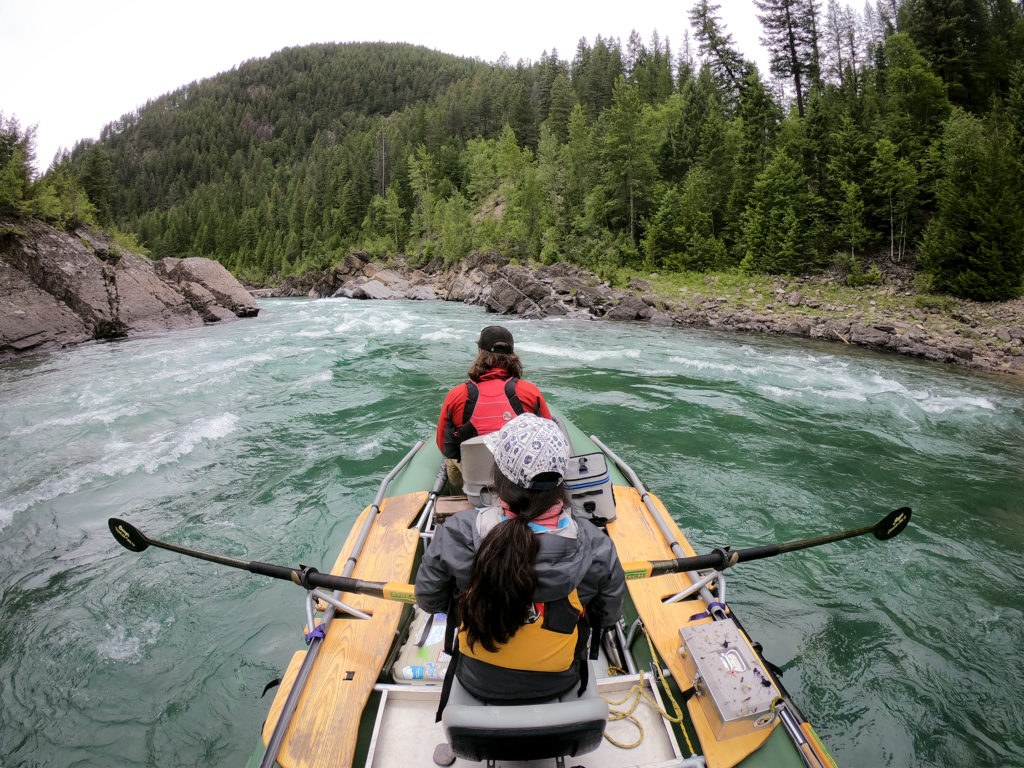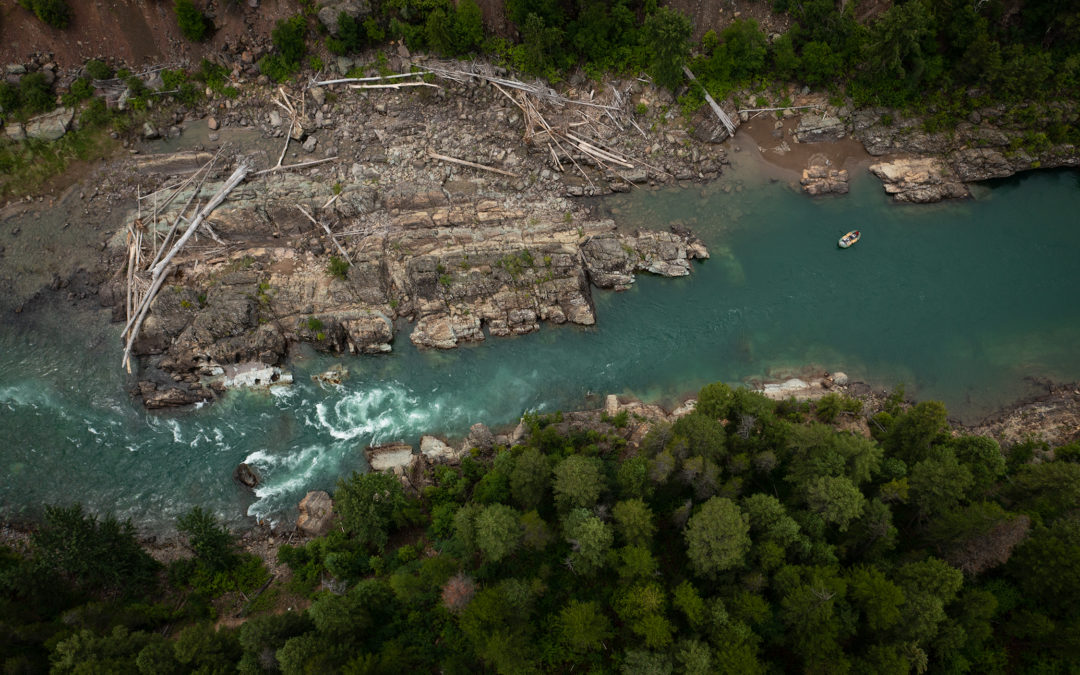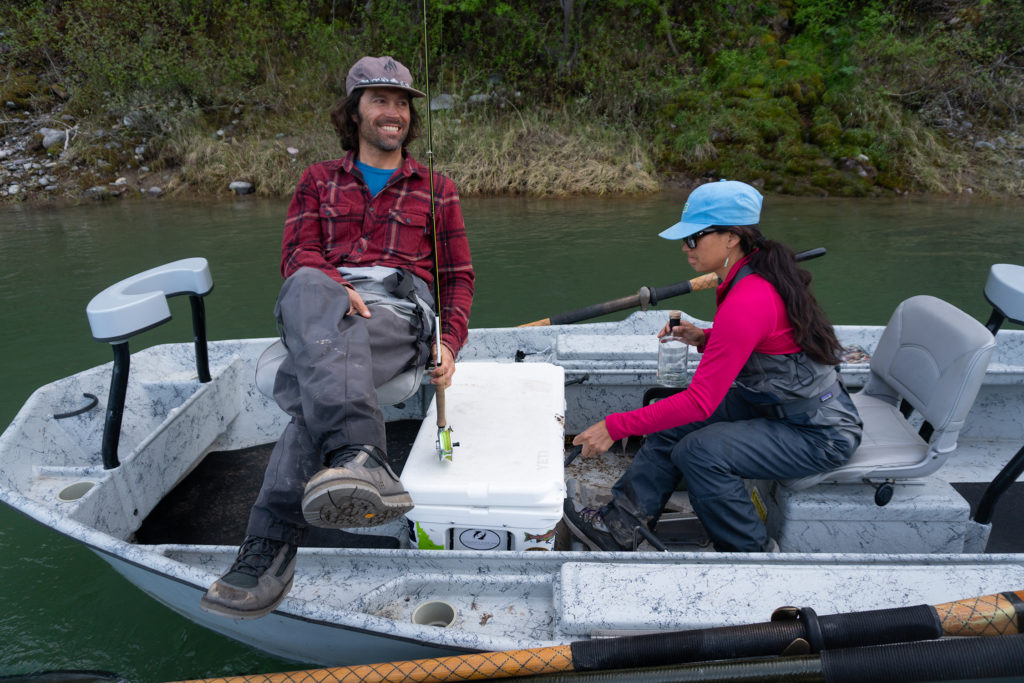Twenty years ago, professional fly fishing guide and POW Alliance Member Hilary Hutcheson was told that her whole world was about to change, thanks to a rapidly warming climate. Over two decades on the rivers in Glacier National Park, Montana, she’s seen that prediction come true. After bearing witness to climate change’s effects on her local rivers and ecosystems, Hutcheson embarked on a film project with director Liam Gallagher, titled Drop, that traced a drop of water from its source high in Montana’s alpine snowpack, through the rivers of Montana, Idaho and Washington and finally into the Pacific Ocean, all while speaking to people whose lives are built around the stability of the water run-off to better paint a picture of the systemic solutions needed to solve these climate impacts.
The climate predictions that inspired the film were made by Dr. Daniel Fagre, a United States Geological Survey (USGS) research ecologist and director of the USGS Climate Change in Mountain Ecosystems Project. An earlier snow runoff was one of the biggest predictions he made, one that Hutcheson has seen impact the rivers she depends on as a guide.
“It would start to become so warm early in the season, that instead of there being a reservoir style drip from the glaciers up high, we would have these mega runoff events that could change habitat, it could change stream beds, it could change river banks and the flows could be really severe,” says Hutcheson. “And then [the runoff] would be over faster, which means that we’re not having the water that we need later on in the summer. This could then lead to a wildfire season that is more catastrophic and causes these huge expenses that we’re seeing across the country, but certainly in the northwest Montana area.”
Join Us For The World Premiere Of Drop! We’re hosting the world premiere of Drop on Earth Day, April 22, at 6:30 p.m. MT. Click here to join us!
The runoff is always looked forward to by anglers in mountain areas, especially in northwest Montana, and the earlier melt date resulted in a boom or bust scenario, where the annual runoff would produce huge river swells that would all of a sudden vanish in the late summer months. A slower run-off cycle provides water storage, and if the run-off happens too early and rapidly, the water supply goes with it, leading to shortages and large-scale wildfires.
Hutcheson also began noticing changes very specific to the fishing community that could affect the unique draw Glacier National Park had for visiting anglers. The native west slope cutthroat trout that was such a draw for Glacier, were hybridizing with rainbow trout. Warming waters provide a habitat where non-native species like rainbow and brown trout can thrive.
“We’re in a relatively intact ecosystem here in Glacier, which means, for the most part, we have all of our species intact and haven’t introduced any other species, and those are non-native species,” says Hutcheson. “With that said, lower in the river system, like at Flathead Lake, there are non-native fish that were introduced. And now because of warming waters, they’re moving up the system. And the hybridization between those non-natives and native west slope cutthroat trout can cause a potential crash of our intact ecosystem. A 20% hybridization leads to a 50% reduction in fitness, resulting in weaker fish over time with less chance of reproduction.”
The rivers in northwest Montana are warming and becoming less habitable for the native west slope cutthroats that entice people to visit the state on fishing trips. There’s a huge draw for anglers who want to catch wild trout in its native habitat, which gives northwest Montana a competitive edge when it comes to earning the business of visiting anglers.
“Our competitive edge is having that cold clean water that is habitable for native fish. So once it starts to get warmer then it’s less habitable for that,” says Hutcheson. “Here in northwest Montana, we have wild native west slope cutthroat trout. And this is virtually the only place people can come to catch one in a relatively intact ecosystem. That’s special to people because this is a freestone river area, so it’s not below a dam. It’s not manipulated by humans. It’s really the way it was when these fish were first recorded. And so people will come here to have the opportunity to catch that fish that really is essentially the same fish as it could have been thousands of years ago.”

And, of course, over twenty years of guiding, Hutcheson has progressively shrunk the number of glaciers she points out to clients on the river. While the national park is named after the glaciers, the total number has shrunk from over 50 to 23 in Hutcheson’s career. All of these climate impacts that Hutcheson has seen, predicted by Dr. Fagre, rippled into the lives of Montana residents who depend on healthy rivers not only for their chosen lifestyles but for their livelihoods. These are the people that Hutcheson and Gallagher highlight throughout the film.
“The first thing that you notice is their selflessness in survival. They’re doing this on the surface level for their own survival, the literal survival of livelihoods. We’re talking with people who are making their living on an outdoor-based economy, specifically a river economy. And so the first thing you see is a need to address the problem because it’s putting food on their table,” says Hutcheson. “But the second thing is the understanding that our tables are all connected. And so the action that they’re taking, and the action of the people who are featured in this film, goes beyond their own livelihoods.”
Hutcheson notes that while many of the people featured in the film began advocating for healthy rivers to provide for themselves and their families. However, their actions have expanded to educating visitors to the region about climate change and how it’s affecting the local ecosystem. While many fishing professionals in the area never signed up to be climate advocates, they’ve assumed the role admirably and have passed along relevant information to others. Normally, speaking to elected leaders about climate solutions, writing letters to publications and paying attention to the scientific changes to the world around you and articulating that to people on your boat or in your shop isn’t part of the job description for guides or outfitters. Now, it’s a prerequisite.
“The changemakers who we have in this film are doing exactly that. They’ve made it a literal part of their business, where they’re being able to stay educated and articulate what’s happening to a greater audience that can do good. And that good is going to be the systemic change,” says Hutcheson.
That good can also be the preservation of one of Montana’s biggest cash cows. Montana has a $7.1 billion outdoor economy that just surpasses the state’s agricultural economy, which is hard to imagine considering the amount of land in the state. That’s why Rachel Schmidt was included in Drop. The former director of outdoor recreation for the state of Montana was able to articulate the economic importance of outdoor recreation for Montanans. During an economic downturn, like the one caused by the COVID-19 pandemic, the continued revenue brought in by outdoor recreation can help keep the economy afloat during the disaster. Businesses may have closed, but the outdoors remained open.
“It’s so important that the economic piece is something that people are considering when they’re making choices in their voting and how they speak to their families about the way they’re operating their households, businesses, communities, city councils and their schools,” says Hutcheson. “Because of that outdoor recreation economy, we had a lot of people’s livelihoods that stood strong and held up throughout this [COVID] disaster, because people were coming into the outdoors, people wanted to be outside, wanted to spend their money outdoors and because that was where they were able to find their solace, their respite and their joy. And that’s something that, you know, Montana has always known. Now, because there was such an increase in that activity, we now have a lot of new stewards hopefully.”
The world of outdoor recreation is going to continue to grow, and rather than looking at the influx of participants as a burden, Hutcheson hopes that people see it as an opportunity to educate others about the importance of protecting the outdoors and being part of bigger solutions. These solutions, specifically tied to the rivers, are highlighted through Drop. There’s Rick Crawford, from Emerger Strategies, a consulting firm that helps fly shops, guiding companies, outfitters and lodges go carbon neutral. The film looks at David McCoy’s shop, one of the first carbon-neutral fly fishing shops in America.
“His influence is huge. And since others saw him do it, we’ve seen more and more individual guides become carbon neutral in their business; lodges become carbon neutral,” says Hutcheson. “These are tourist destinations where western anglers from the US are going and they’re starting now to choose those carbon-neutral places because they have options. It’s a very big impact that these people in the movie are making because now we’re giving the outdoor industry options for how they can vote with their pocketbook.”
“The changemakers who we have in this film are doing exactly that. They’ve made it a literal part of their business, where they’re being able to stay educated and articulate what’s happening to a greater audience that can do good. And that good is going to be the systemic change.”
Hilary Hutcheson
Hutcheson and Gallagher correlated potential climate solutions with the people featured in the film. Drop begins in Montana’s high peaks with Hutcheson and legendary professional snowboarder and POW founder Jeremy Jones. This is the start of the journey, where snow will eventually melt and trickle down in the mountainsides into the rivers. Hutcheson says it was very intentional to feature Jones early on in the film, as they wanted to showcase what climate leadership looked like and convey that it’s less about making a small change to the efficiency of your house, for example, and more about educating people who have a great influence but aren’t necessarily up to speed about climate change.
“We start off the film with Jeremy Jones to showcase that kind of bravery and executive action. He made a choice to do something and didn’t do it all on his own because he needed all of these people to be able to get in front of the problem and then also train them on how to speak about it,” says Hutcheson. “That’s why I joined POW because I saw Jeremy teaching people how to speak to their communities and to their elected leadership. And there wasn’t anything like that anywhere in the outdoor industry, where you were actually getting trained about how to go to Washington and or to Helena or to your city council.”

Jeremy Jones and Hilary Hutcheson during the filming of “Drop.” 
The crew plans out the adventure during the filming of “Drop.”
And each subsequent character represents an idea or solution that viewers could think about incorporating in their own communities. There’s Schmidt, who wants people to find connections through recreation that lead to more productive conversations surrounding the protection of the natural spaces that support the outdoor recreation economy. Or Crawford, who reminds us that capitalism isn’t going away anytime soon, so if we can do capitalism better by helping businesses go carbon neutral, let’s do that. Or Russ Ricketts, who is snorkeling in the Wenatchee River in Washington to capture data that people can see with their own eyes to identify the dire need for action, all with a little adrenaline pumped in for good measure.
“That’s where the hope comes from for me, because, you know, that’s just a handful of people who we were able to highlight through this film. But there’s so much more out there,” says Hutcheson. “What gave me the most hope and optimism after making Drop is that there is still so much to do. And that might seem grim. But the reason I find hope and optimism with how much more there is after this film is because we just scratched the surface with the characters who were found by this drop of water just flowing from the top of the Continental Divide to the Pacific Ocean. There are so many more people like that with solutions out there. So I hope that people look at themselves as the drop of water flowing through these communities.”
Join Us For The World Premiere Of Drop!
This new film from POW Alliance Member and fly-fishing guide Hilary Hutcheson follows a drop of water from its source high in the mountains of Montana to its final destination of the Pacific Ocean. Throughout the film, we meet the people who live, work and play on these rivers—people who work tirelessly to ensure that these waters, and all they support, are healthy. Through this dedication, hard work and passion, Drop illustrates how the water connects us all. POW is hosting the Drop world premiere on Earth Day, and we want you to join!




